Your smartwatch loses music streaming connection primarily due to Bluetooth interference from Wi-Fi routers and other 2.4 GHz devices competing for the same frequency. Physical barriers like walls, metal surfaces, and even your clothing can weaken signals, while exceeding the typical 10-30 foot indoor range causes dropouts. Software issues including outdated firmware, app crashes, cache buildup, and incompatible versions also disrupt streaming. Understanding these specific causes will help you implement targeted solutions.
Bluetooth Signal Interference From Nearby Devices
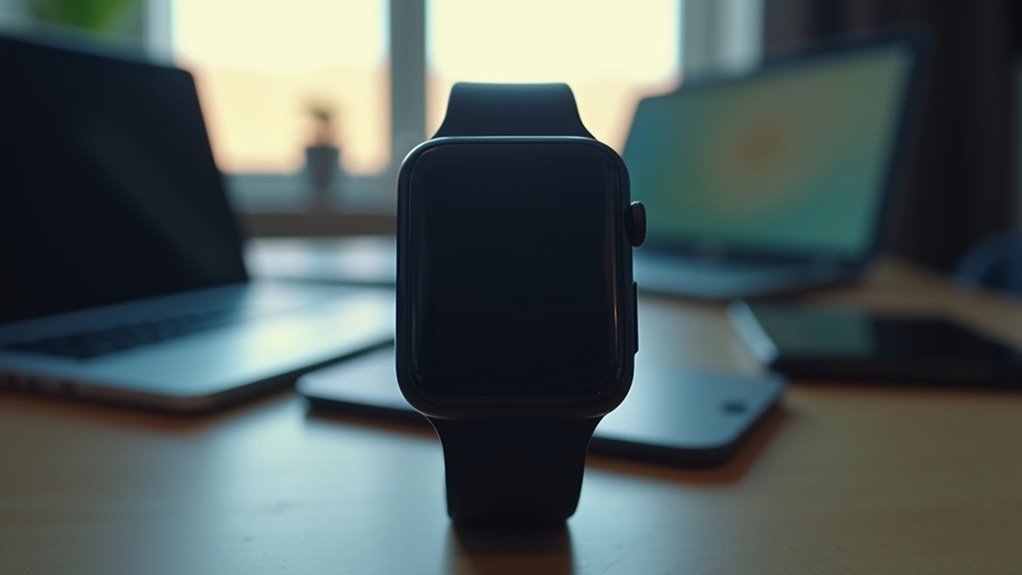
When your smartwatch struggles to maintain a steady music streaming connection, Bluetooth signal interference from nearby devices is often the culprit. Your smartwatch operates on the same 2.4 GHz frequency as Wi-Fi routers, creating competing signals that disrupt connections.
Device overcrowding compounds this problem—when multiple Bluetooth devices operate in close proximity, they interfere with each other’s signals.
Common interference sources include microwaves, smart home devices, wireless keyboards, and satellite dishes.
Even building materials like metal and concrete can weaken your smartwatch’s signal, making it more susceptible to interference.
Ironically, your smartwatch can also cause interference affecting other devices’ music streaming connections. This interference manifests as poor audio quality, frequent disconnections, streaming delays, and occasional device restart requirements to reestablish stable connections. Many users find that temporarily turning off Bluetooth on their smartwatch resolves interference with other connected devices.
Physical Obstructions Blocking Wireless Connections
Beyond interference from competing devices, physical obstructions create another notable barrier to your smartwatch’s music streaming performance. Walls, dense objects, and conductive materials like metal can weaken or completely block wireless signals between your watch and router.
| Common Obstructions | Impact Level |
|---|---|
| Thick walls/concrete | High |
| Metal surfaces/frames | Very High |
| Furniture/appliances | Medium |
Your room’s layout notably affects signal strength. Metal and water absorb wireless signals most effectively, causing frequent disconnections. Environmental factors like humidity and temperature also compromise signal quality.
You can improve connectivity by strategically positioning your router away from barriers, using Wi-Fi extenders to bypass obstructions, or relocating to areas with clearer signal paths for uninterrupted streaming. Strategic router placement can minimize obstruction and help maintain consistent connections between your smartwatch and wireless network.
Exceeding Optimal Device Proximity Range
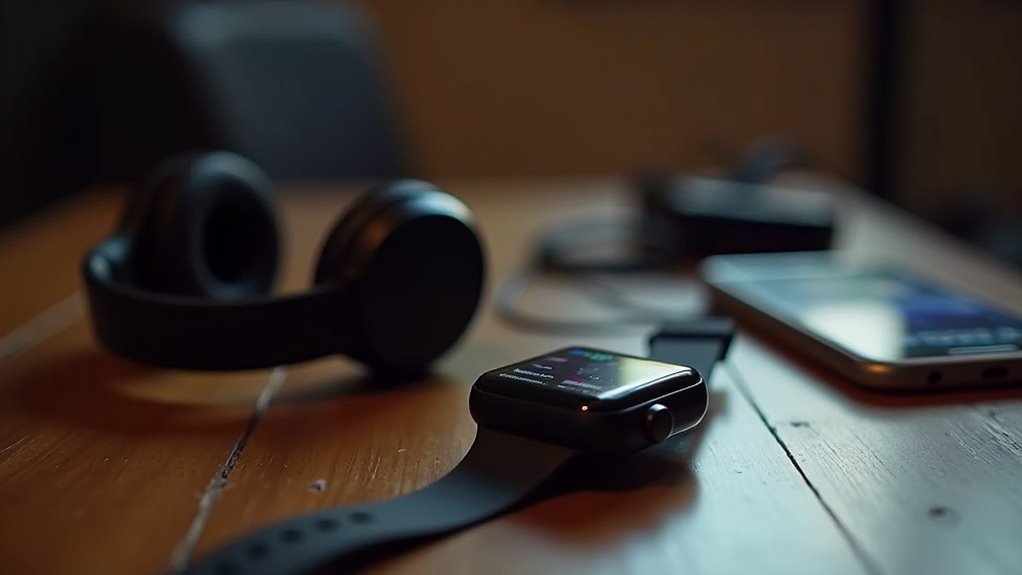
One of the most overlooked factors affecting your smartwatch’s music streaming performance involves the distance between your watch and connected devices.
Most smartwatches rely on Bluetooth connectivity, which typically works within 30 feet in open spaces. However, real-world conditions often reduce this range to 10-30 feet indoors due to walls, metal objects, and wireless interference.
When you exceed your device’s ideal proximity range, you’ll experience lag, buffering, or complete streaming loss. Moving while exercising commonly triggers these disconnections.
Manufacturers like Apple claim ranges up to 330 feet, but these figures represent ideal conditions rarely achieved in practice.
Smartwatches with Wi-Fi capability can maintain streaming beyond Bluetooth limits when connected to the same network, offering remarkably better range flexibility. Some advanced models also feature cellular connectivity options that eliminate dependency on nearby phones entirely.
App Crashes and Software Malfunctions
You’ll likely encounter frequent app crashes when streaming music on your smartwatch, especially if you’re running multiple applications simultaneously or using resource-intensive streaming services.
These crashes often stem from software compatibility problems between your smartwatch’s operating system and the music streaming app, particularly when either hasn’t been updated to work seamlessly together.
Your device’s limited processing power and memory can quickly become overwhelmed during persistent streaming sessions, causing apps to freeze or shut down unexpectedly. The crashes may also trigger battery misreporting, where your watch incorrectly displays a much lower charge level than actual after rebooting.
Frequent App Crashes
When your smartwatch music streaming app crashes repeatedly, the underlying culprits typically stem from insufficient memory, outdated software versions, or background app interference that overwhelms your device’s limited processing power.
You’ll notice disrupted playbook, connection timeouts, and pairing failures that force manual reconnection attempts. Users commonly report instant crashes on launch, loading screen freezes, or apps that won’t open at all.
To resolve these issues, restart both your watch and phone first. Update your software and streaming apps regularly, then uninstall and reinstall problematic music apps. Many streaming apps require installation on both your watch and phone to function properly, which can compound compatibility issues.
Check for conflicting applications that might disrupt performance. If crashes persist, consider a factory reset as your last resort, though this carries potential risks you should weigh carefully.
Software Compatibility Problems
Software compatibility problems create a cascade of frustrating issues that extend far beyond simple app crashes, affecting every aspect of your smartwatch’s music streaming experience.
When your streaming app isn’t optimized for your watch’s operating system, you’ll encounter frequent malfunctions and unexpected disconnections. Inadequate or irregular updates worsen these compatibility issues, leaving your device struggling to maintain stable connections with popular streaming services.
Your smartwatch’s limited file format support can reject certain audio types, causing streaming interruptions. Third-party apps often integrate poorly with smartwatch systems, creating additional streaming failures.
Weak Bluetooth connectivity compounds these problems, as poor signal strength and interference disrupt your music flow. These compatibility conflicts force your device to work harder, draining battery faster and creating a cycle of performance degradation that affects your entire streaming experience. Installing the companion apps required by your smartwatch manufacturer can help resolve many of these software-related connectivity problems by ensuring proper communication protocols between devices.
Outdated Firmware and Software Versions
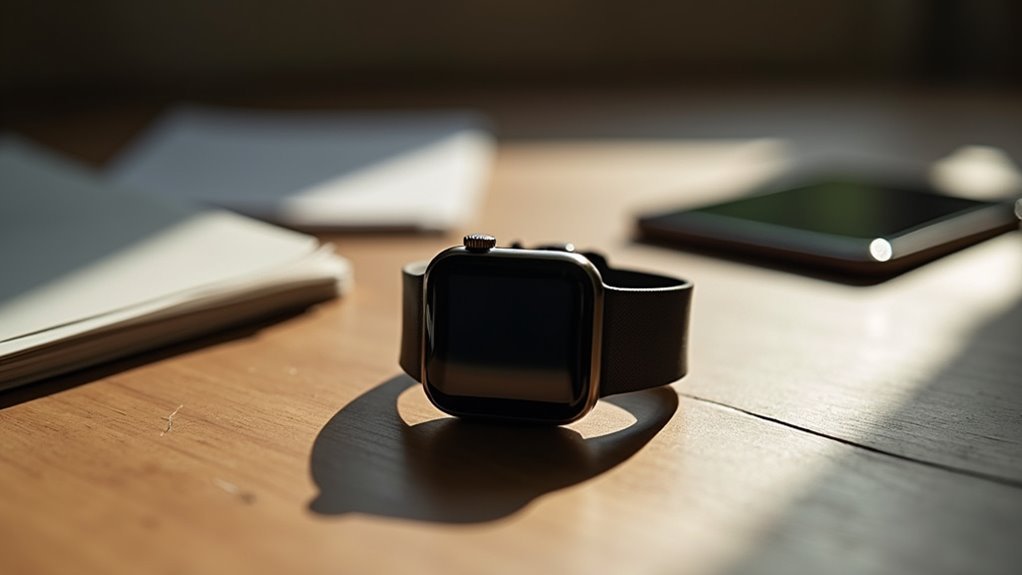
Your smartwatch’s outdated firmware and software versions can be the silent culprits behind persistent music streaming failures.
When you’re running old firmware, you’re missing critical bug fixes, Bluetooth protocol improvements, and compatibility updates that streaming apps need to function properly.
Understanding why firmware updates matter, how software compatibility affects your device, and the proper update installation process will help you maintain stable streaming connections. With the smartwatch app ecosystem expanding rapidly by 40% in the last year, keeping your device updated ensures compatibility with the latest streaming applications and their evolving requirements.
Firmware Update Importance
Although many users overlook firmware updates as minor inconveniences, they’re actually critical for maintaining stable music streaming on your smartwatch. Outdated firmware creates compatibility gaps with streaming services’ evolving APIs and newer Bluetooth protocols, resulting in frequent disconnections and timeouts.
| Update Benefit | Streaming Impact |
|---|---|
| Protocol Support | Maintains Bluetooth/Wi-Fi connectivity |
| API Compatibility | Prevents service disruptions |
| Bug Fixes | Reduces disconnection frequency |
| New Features | Enables offline syncing capabilities |
Manufacturers release firmware updates multiple times yearly, addressing these connectivity issues and adding streaming enhancements. You’ll typically receive notifications through companion apps, though some require manual checking. Modern updates now include offline music playback capabilities that allow your smartwatch to store and play music independently without requiring a phone connection. Ignoring these updates leaves your device vulnerable to persistent streaming problems and missing features like direct music downloads.
Software Compatibility Issues
Beyond outdated firmware, incompatible software versions create a cascade of streaming problems that’ll disrupt your music experience.
Your streaming apps mightn’t be optimized for your specific smartwatch model, causing frequent connection interruptions. When your streaming app updates don’t match your watch OS version, you’ll experience crashes and dropped streams.
Your watch’s Bluetooth software stack can be outdated, leading to unstable audio connections and frequent drops.
The OS-level streaming buffer management becomes inefficient with older software, causing audio playback interruptions and memory allocation problems.
Your watch’s aggressive background app restrictions preserve battery life but terminate music streams unexpectedly. Disable background running apps to enhance battery longevity and prevent unexpected streaming termination.
Software conflicts between streaming apps and watch OS libraries cause crashes, while third-party app interference disrupts your streaming stability through non-optimized background activities.
Update Installation Process
When your smartwatch’s firmware becomes outdated, updating it requires careful preparation to guarantee the process completes successfully.
You’ll need at least 30% battery charge and should place your watch near your paired phone to maintain stable Bluetooth connectivity. Make sure you’ve got sufficient storage space and a reliable internet connection before starting.
Navigate to your watch’s Settings menu or use the companion app to initiate the update. Follow the on-screen prompts and don’t disconnect power or Bluetooth during installation.
Your watch will automatically reboot and show progress indicators. If the update fails due to connectivity issues or low battery, you’ll need to retry after addressing these problems. Keeping firmware current enhances device performance and prevents various connection issues with streaming services.
Successful installation will restart your device automatically.
Network Bandwidth Congestion Issues
Network congestion occurs when your smartwatch attempts to stream music through a network that’s handling more data than its capacity allows.
When too many devices compete for bandwidth simultaneously, your streaming connection suffers from packet loss and delays.
You’ll notice interruptions during peak usage hours when network utilization spikes, especially on mobile networks.
Bandwidth-hogging devices monopolize resources your smartwatch needs for continuous playbook.
Insufficient network capacity and poor infrastructure create bottlenecks that disrupt your music stream.
Oversubscription by service providers means more users than the network can handle, causing congestion when everyone’s streaming.
Your smartwatch experiences jitter, latency spikes, and reduced throughput, leading to buffering or complete connection drops during these congested periods. Packet retransmissions occur when your smartwatch’s data packets are lost or damaged during transmission, further worsening the congestion and causing additional streaming delays.
Device Compatibility Problems
Device compatibility problems create another major barrier to seamless music streaming on your smartwatch. Your watch’s operating system—whether WearOS, Tizen, or Garmin OS—handles streaming services differently, and not all platforms offer dedicated smartwatch app support.
Cross-brand pairing between your phone and watch often leads to incomplete feature support, with some manufacturers restricting access to maintain platform exclusivity.
Hardware limitations compound these issues. Your watch may lack onboard LTE or Wi-Fi for standalone streaming, while Bluetooth protocol mismatches between devices cause pairing errors and connectivity interruptions.
Firmware updates don’t always include the latest streaming features, and some brands block full integration with competing devices. Even after watch resets, users may find their previously working music controls reduced to basic functions like playlist visibility and playback start only. These manufacturer-specific limitations greatly impact your streaming experience across different device ecosystems.
Environmental Electronic Interference
Beyond your watch’s internal compatibility struggles, electromagnetic interference (EMI) from surrounding electronics can disrupt your music streaming in ways you mightn’t expect.
Your smartwatch’s compact design leaves little room for protective shielding, making it vulnerable to interference from nearby devices like cell phones, heated gloves, and even microwaves.
Your smartwatch’s minimal shielding makes it susceptible to interference from phones, appliances, and other nearby electronic devices.
Dense electronic environments amplify this problem. When you’re in crowded offices, gyms, or cafes, multiple devices create competing electromagnetic fields that can cause signal dropouts, audio distortion, and connection lag.
Your watch’s Bluetooth and WiFi signals struggle to maintain stable connections amid this electronic noise.
Urban areas present greater challenges than rural locations due to higher device density and infrastructure.
Lightning, electrical surges, and power fluctuations can also introduce unpredictable interference, forcing your watch to repeatedly reconnect and disrupting your listening experience. To minimize disruption, maintain at least 50 cm distance between your smartwatch and other electronic devices whenever possible.
Insufficient Bluetooth Signal Strength
Your smartwatch’s Bluetooth signal weakens dramatically as distance increases between your watch and headphones, typically failing beyond 30 feet for most devices.
Physical barriers like your body, clothing, or nearby walls can block or absorb the radio waves, forcing you to keep devices uncomfortably close together. Additionally, Bluetooth interference from other wireless devices in the area can disrupt your music streaming connection.
You’ll notice choppy audio or complete dropouts when your watch can’t maintain a strong enough connection to stream music reliably.
Distance and Proximity
When you’re experiencing music streaming interruptions on your smartwatch, insufficient Bluetooth signal strength due to distance and proximity issues is often the culprit.
Bluetooth’s typical range is about 30 feet, but you’ll notice performance degrades well before reaching that limit. Physical obstacles between your watch and headphones weaken the signal, causing stuttering or dropped audio.
Your wrist position matters too—some users find better performance with the watch on their right wrist. Additionally, tight-fitting clothing around the watch area can interfere with signal transmission and cause connectivity problems.
Environmental interference from Wi-Fi routers, microwaves, and other 2.4 GHz devices compounds distance problems. Multiple Bluetooth devices nearby create channel congestion, making your connection even more unstable.
As signal strength decreases with distance, your smartwatch becomes more susceptible to interference, resulting in frustrating disconnections during your workout or commute.
Physical Barrier Impact
Physical obstacles between your smartwatch and connected devices create the most significant barriers to stable Bluetooth connections. Thick walls, closed doors, and large furniture block Bluetooth signals, with concrete and metal materials causing the most severe attenuation.
Metal surfaces like cabinets and appliances don’t just block signals—they reflect them, creating multipath interference that degrades connection quality.
You’ll notice worse performance when multiple barriers exist between devices. Dense materials absorb Bluetooth energy, while complex room layouts with frequent obstructions amplify signal loss through absorption, reflection, and diffraction. Bluetooth devices operating in the ISM band can experience reduced signal strength when physical barriers interfere with the 2.400 to 2.485 GHz frequency range.
To minimize these issues, position your devices with clear line-of-sight when possible. Avoid placing your phone near metal objects, and choose locations that reduce the number of walls and large obstacles between your smartwatch and music source.
Improper Device Pairing and Sync Settings
Although Bluetooth technology has revolutionized how smartwatches connect to smartphones for music streaming, improper device pairing remains one of the most frequent culprits behind frustrating connection drops and audio interruptions.
You’ll experience unstable connections when your devices don’t have consistent Bluetooth settings or when you’ve completed the pairing process incorrectly.
Your sync settings can also disrupt music streaming. Limited bandwidth from other activities, overlapping sync schedules, and excessive background data usage all compete for resources.
When you’re syncing podcasts or running multiple apps simultaneously, you’re reducing available bandwidth for smooth audio streaming. Maintaining your watch at 100% charge during the sync process helps ensure stable connections and prevents power-related interruptions.
Restarting both your smartwatch and phone often resolves these pairing issues, while adjusting sync schedules prevents conflicts that interrupt your music experience.
Cache and Data Storage Conflicts
Cache buildup silently sabotages your smartwatch’s music streaming performance by consuming precious storage space and creating conflicts between apps.
When excessive cache accumulates, your watch’s operating system slows down, causing streaming apps to lag and disconnect unexpectedly. Corrupted cache data interferes with app processes, while storage consumed by cache leaves less memory for music buffering.
Multiple streaming apps can store data in overlapping locations, creating conflicts that disrupt playback. App updates may modify storage structures, breaking previously stored music files or settings. Outdated app versions can create additional instability issues that compound existing cache problems.
When background processes simultaneously access the same music data, streaming stability suffers.
Your smartwatch’s less sophisticated cache management compared to phones increases failure risk. You’ll need to manually clear cache regularly since third-party cleaning tools are rarely available for wearables.
Battery Power and Performance Degradation
Your smartwatch’s battery becomes the critical bottleneck that determines whether music streaming succeeds or fails during extended listening sessions. With only 300-400 mAh capacity, your device can’t sustain power-hungry features like GPS, LTE, and Bluetooth simultaneously without compromising connection stability.
| Battery Impact Factor | Effect on Streaming |
|---|---|
| High-power features (GPS/LTE) | Rapid battery drain, connection loss |
| Multiple sensors running | Reduced streaming endurance |
| Aging battery cells | Faster discharge, earlier disconnection |
| Background app activity | Inconsistent connection quality |
As your battery ages, you’ll notice shorter streaming sessions before connections drop. Power-intensive apps increase processor workload, accelerating discharge rates. Software optimizations help, but battery saver modes often cause intermittent disruptions that compromise your listening experience. Background processes running on your smartwatch continue consuming power even when you’re not actively using the device, further contributing to connection instability during music streaming.
Frequently Asked Questions
Can Wearing the Smartwatch on Different Wrists Affect Music Streaming Connection Stability?
Wearing your smartwatch on different wrists can affect streaming stability. Your arm movement, wristband material, and device positioning influence signal strength. You’ll experience better connectivity when you minimize interference and maintain ideal positioning.
Do Certain Music Streaming Services Work Better Than Others With Smartwatches?
Yes, you’ll find Apple Music works better on Apple Watch with superior integration, while Spotify offers broader cross-platform compatibility. Your watch’s hardware limitations and storage capacity affect performance more than service choice.
How Often Should I Restart My Smartwatch to Prevent Connection Issues?
You should restart your smartwatch every few days or when connection issues arise. Regular reboots clear cached data, reset Bluetooth protocols, and prevent software glitches that cause music streaming disconnections.
Does the Smartwatch’s Storage Capacity Impact Music Streaming Connection Quality?
Your smartwatch’s storage capacity doesn’t affect streaming connection quality. Storage only matters for offline music downloads. Streaming depends on Wi-Fi or Bluetooth strength, not how much internal storage you’ve got available.
Can Weather Conditions Like Humidity or Temperature Affect Bluetooth Music Streaming?
Yes, you’ll experience disrupted Bluetooth music streaming when humidity absorbs signals or extreme temperatures drain your smartwatch’s battery faster. Rain, snow, and electromagnetic interference from storms can also weaken connections considerably.
In Summary
You’ll experience fewer music streaming interruptions by addressing these common connection issues. Keep your smartwatch within ideal range of your phone, update firmware regularly, and clear cached data when problems arise. Check for Bluetooth interference from other devices and guarantee proper pairing settings. If you’re still having connectivity problems, restart both devices and re-establish the connection. Most streaming issues stem from simple troubleshooting steps you can handle yourself.

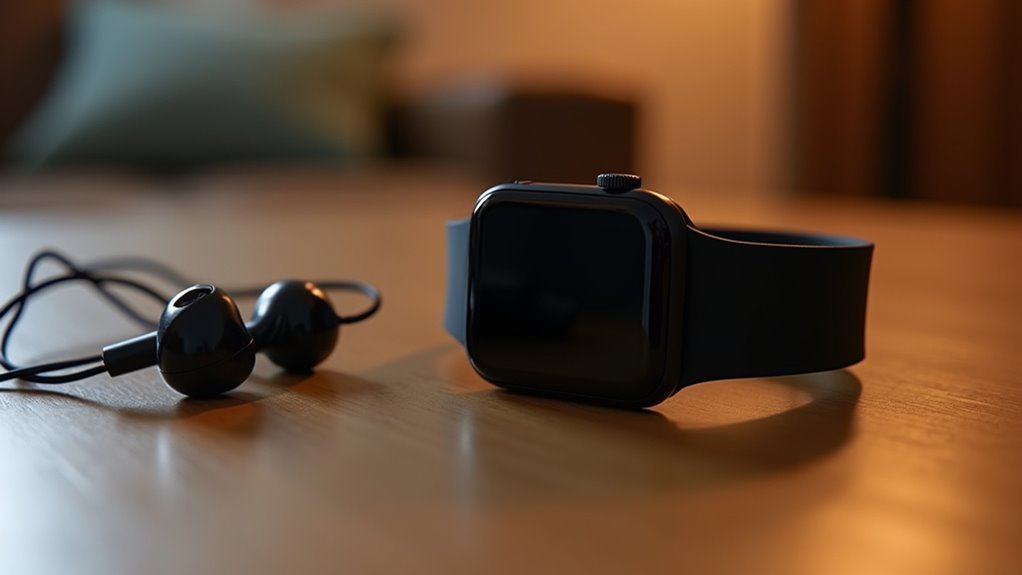

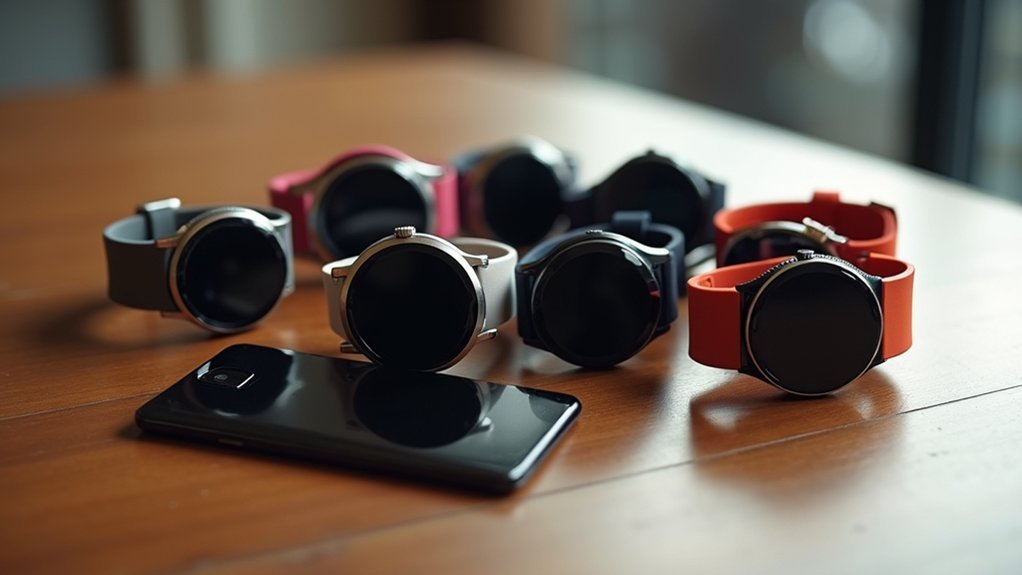
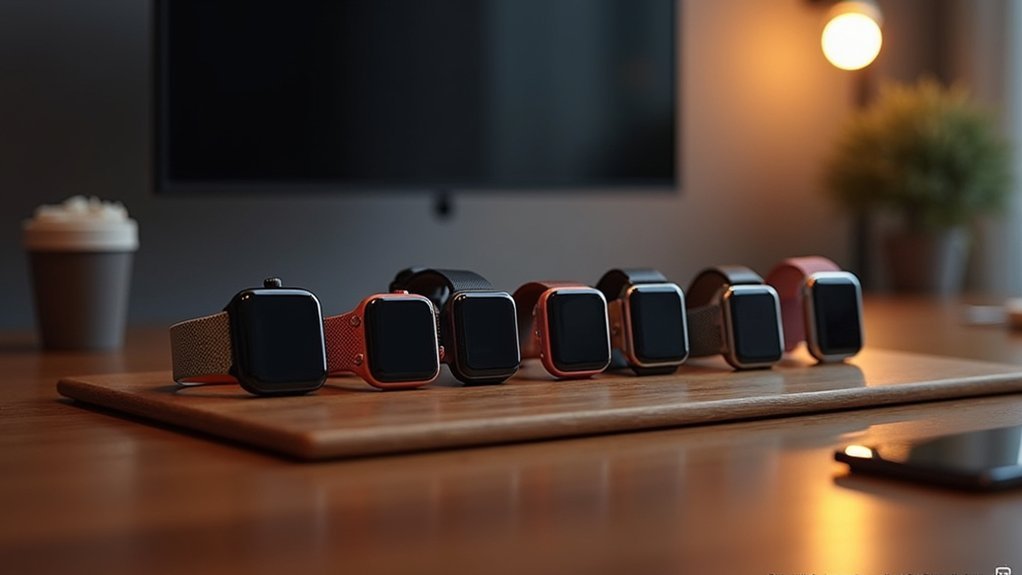
Leave a Reply